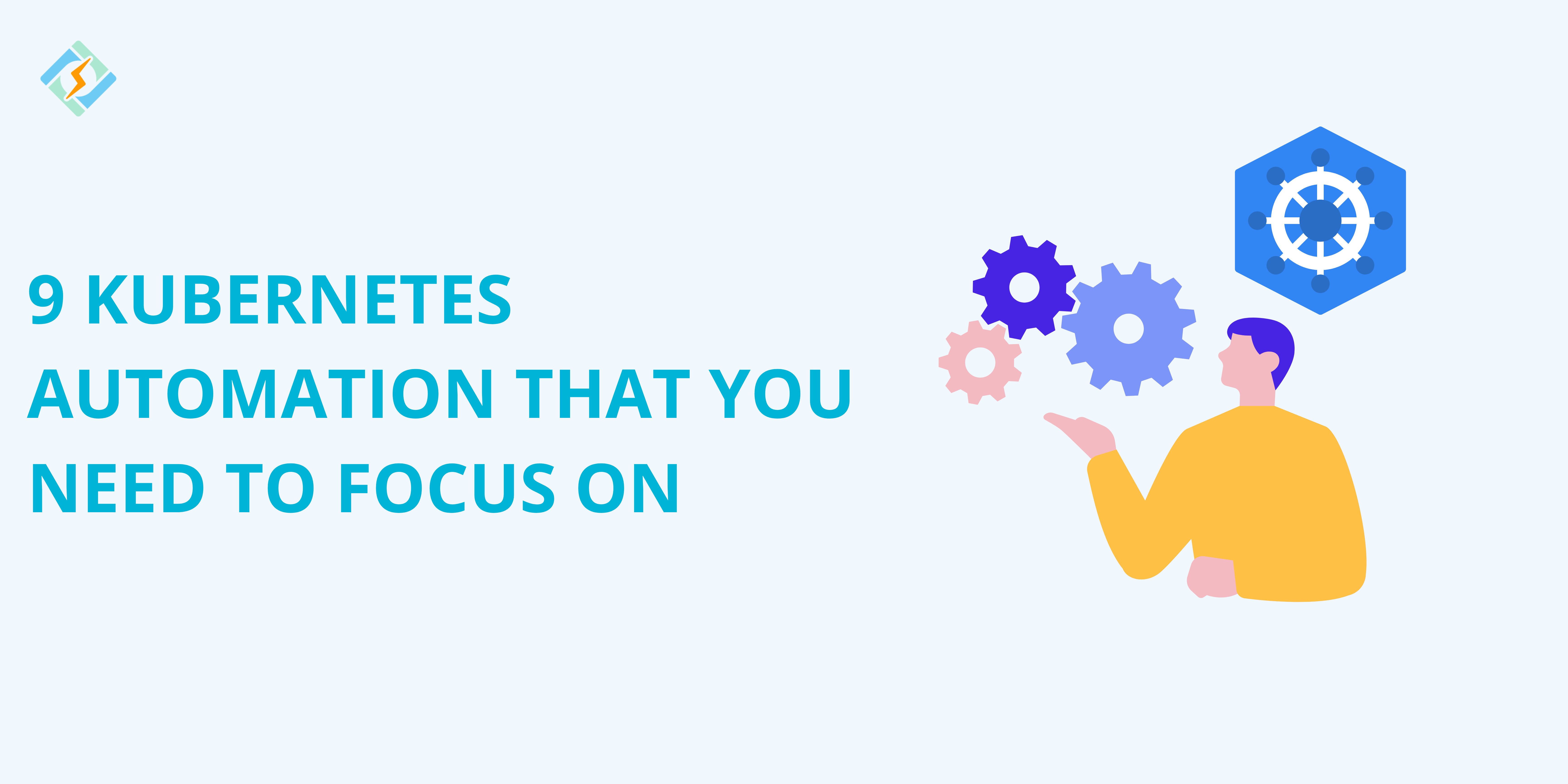Managing Kuberenetes manually is an overwhelming task especially at the infrastructure scale. Automation is essential for efficiency, scalability, and reliability, which allows you to streamline operations, reduce human error, and improve overall performance.
This guide will show when you need to turn to Kubernetes automation and top 9 automations that you need to focus on.
When to Use Kubernetes Automation
Kubernetes automation is crucial for scalability, efficiency, and reliability in containerized environments. Here are some use cases to use Kubernetes automation:
- Managing large scale deployments
- Auto scaling applications
- Continuous Deployment (CI/CD)
- Load balancing and traffic management
- Secret and configuration management
- Monitoring and logging
- Disaster recovery and backups
- Security and compliance
- Kubernetes upgrades and patch management
Top 9 Essential Kubernetes Automation
To minimize manual labour with Kubernetes, you can follow these automation techniques.
- Automating Kubernetes Cluster Provisioning
Provisioning a Kubernetes cluster manually is time-consuming and prone to human error, which is why automating it would ensure consistency and easy repeating across multiple environments.
Example Tools:
Get exclusive access to all things tech-savvy, and be the first to receive
the latest updates directly in your inbox.
- Terraform helps automate infrastructure provisioning with Kubernetes clusters on cloud.
- Ansible automates Kubernetes installation on bare metals and virtual machines.
- Kops, also known as Kubernetes Operations, which deploy production ready clusters.
Example – Terraform for Cluster Provisioning:
provider “aws” {
region = “us-east-1”
}
resource “aws_eks_cluster” “example” {
name = “my-cluster”
role_arn = aws_iam_role.example.arn
vpc_config {
subnet_ids = aws_subnet.example[*].id
}

}
This Terraform code provisions an AWS EKS cluster, ensuring automated deployment and scaling.
- Automating Application Deployment
Manually deploying applications can lead to inconsistencies, which is why automation is important for version control, rollback capabilities, and environment-specific configurations.
Example Tools:
- Helm is a package manager.
- AgroCD is a GitOps based continuous delivery tool.
- Kustomize manages Kubernetes configurations without modifying the base files.
Example – Deploying an App with Helm:
helm repo add bitnami https://charts.bitnami.com/bitnami
helm install my-nginx bitnami/nginx
This command installs Nginx on a Kubernetes cluster using Helm.
- Automating Scaling with Horizontal Pod Autoscaler (HPA)
HPA automatically adjusts the number of running pods in Kubernetes based on CPU. It is an excellent choice to restart a pod in Kubernetes for dynamically scaling applications.
Example Tools:
- Kubernetes HPA has a built-in Kubernetes feature that scales pods.
- KEDA (Kubernetes Event-Driven Autoscaling) enables scaling based on event-driven metrics (e.g., queue length, HTTP requests).
Example – HPA Configuration:
apiVersion: autoscaling/v2
kind: HorizontalPodAutoscaler
metadata:
name: my-app-hpa
spec:
scaleTargetRef:
apiVersion: apps/v1
kind: Deployment
name: my-app
minReplicas: 2
maxReplicas: 10
metrics:
– type: Resource
resource:
name: cpu
target:
type: Utilization
averageUtilization: 70
This HPA configuration ensures that if CPU usage exceeds 70%, new pods are automatically added.
- Automating Load Balancing and Traffic Management
For optimal performance, it is important to efficiently route traffic. It helps divide traffic from incoming requests across different pods, preventing overload on a single instance. Automation ensures seamless failover, reducing downtime and improving user experience.
Example Tools:
- Ingress Controllers manage HTTP/S routing to backend services.
- MetalLB provides load balancing for on-prem Kubernetes clusters.
Example – NGINX Ingress Controller:
apiVersion: networking.k8s.io/v1
kind: Ingress
metadata:
name: my-ingress
spec:
rules:
– host: myapp.example.com
http:
paths:
– path: /
pathType: Prefix
backend:
service:
name: my-service
port:
number: 80
This configures an Ingress rule to route traffic to my-service when accessing myapp.example.com.
- Automating Secrets and Config Management
Securing sensitive data is essential to prevent credentials from being exposed. Kubernetes automation ensures that secrets are well encrypted, access-controlled, and dynamically updated without human intervention.
Example Tools:
- Kubernetes Secrets stores encrypted credentials.
- HashiCorp Vault manages secrets dynamically.
- ConfigMaps manages application configurations.
Example – Creating a Kubernetes Secret:
apiVersion: v1
kind: Secret
metadata:
name: my-secret
type: Opaque
data:
password: cGFzc3dvcmQ= # Base64 encoded
This secret stores an encrypted password in Kubernetes.
- Automating CI/CD Pipelines for Kubernetes
CI/CD Kubernetes automation is essential for application integration, testing, and deployment. It ensures faster and accurate releases by automatically building and deploying code changes, eliminating human error.
Example Tools:
- Jenkins X is a Kubernetes-native CI/CD automation.
- GitHub Actions automates Kubernetes deployments.
- ArgoCD is a GitOps-based deployment.
Example – GitHub Actions for Kubernetes Deployment:
name: Deploy to Kubernetes
on:
push:
branches:
– main
jobs:
deploy:
runs-on: ubuntu-latest
steps:
– name: Checkout code
uses: actions/checkout@v2
– name: Deploy to Kubernetes
run: kubectl apply -f deployment.
This GitHub Actions workflow automates Kubernetes deployments when code is pushed to the main branch.
- Automating Security and Compliance Checks
It is important to ensure security compliance by continuously monitoring configurations and enforcing security best practices. It helps to identify threats and mitigate in real-time, eliminating security breaches.
Example Tools:
- OPA enforces security policies.
- Kyverno is a Kubernetes-native policy manager.
- Falco detects runtime security threats.
Example – OPA Policy to Restrict Privileged Containers:
package kubernetes.admission
deny[msg] {
input.request.kind.kind == “Pod”
input.request.object.spec.containers[_].securityContext.privileged == true
msg := “Privileged containers are not allowed!”
}
This OPA policy denies any pod running with privileged access.
- Automating Disaster Recovery and Backups
It helps eliminate data loss by regularly saving the snapshots of cluster states and persistent volumes. It helps with automated restoration processes enabling rapid recovery, ensuring business continuity.
Example Tools:
- Velero backs up Kubernetes clusters.
- Kasten K10 is a Kubernetes-native backup and disaster recovery.
Example – Velero Backup Command:
velero backup create my-cluster-backup –include-namespaces=my-namespace
This command backs up a namespace in a Kubernetes cluster.
- Automating Kubernetes Upgrades and Patch Management
Automating backups ensure that critical data is regularly captured and stored securely in case of natural disasters. This minimizes downtime during loss and failures.
Example Tools:
- Kubeadm manages Kubernetes cluster upgrades.
- Kured automates node reboots for updates.
Example – Upgrading a Cluster with kubeadm:
kubeadm upgrade plan
kubeadm upgrade apply v1.25.0
This updates the Kubernetes cluster to version 1.25.0 with minimal downtime.
Wrapping Up – The Future Of Kubernetes Automation
As systems get more complex, it is important to move towards Kubernetes automation to eliminate human error and minimize downtime. This guide is a good starting point to get you started!
1. How can I automate application deployment in Kubernetes?
You can use CI/CD pipelines with tools like ArgoCD or Flux to automate deployments, ensuring faster and more reliable updates.
2. Can Kubernetes automation improve security?
Yes, automation enforces security policies, scans for vulnerabilities, and manages secrets securely, reducing risks of misconfigurations and breaches.
3. What tools help with Kubernetes automation?
Popular tools include Terraform for infrastructure provisioning, Helm for package management, and Kustomize for configuration management.



